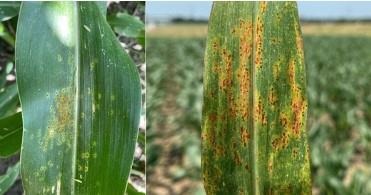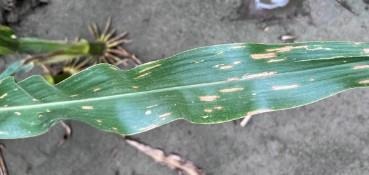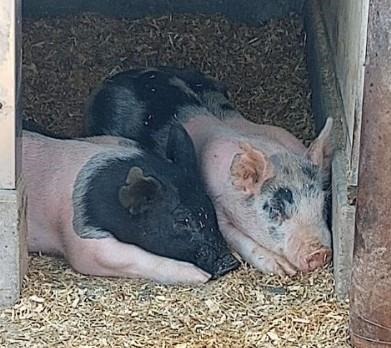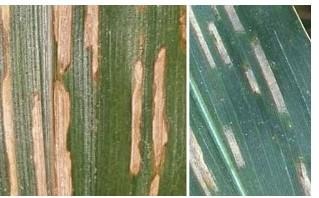We are entering the time window in Kansas where corn producers should be scouting fields and assessing the need for a foliar fungicide application. Several fields in eastern Kansas are approaching V14-VT (tassel) development stage.
Now is the time to be out scouting for the following fungal diseases of corn:
- Southern rust (Figure 1, left)
- Common Rust (Figure 1, right)
- Gray leaf spot (Figure 2)
- Tar Spot (Figure 3)

Figure 1. Typical symptoms of southern rust (left) and common rust (right). Photo courtesy of Rodrigo Borba Onofre, Department of Plant Pathology, K-State Research and Extension.
Southern rust scouting. Southern rust is typically first reported in Kansas in mid-July. Pustules will appear on the upper leaf surface (unlike common rust which can be found on either side of the leaf). Pustules will be scattered on the leaf surface and spores will appear orange and will rub off on fingers (and clothes!). Severe infections can be seen on the leaf sheaths.

Figure 2. Gray leaf spot lesions are rectangular in shape and delimited by leaf veins. Photo courtesy of Rodrigo Onofre, Department of Plant Pathology, K-State Research and Extension.
Gray leaf spot scouting. Begin scouting for gray leaf spot in corn about two weeks before expected tassel emergence. Gray leaf spot is characterized by rectangular lesions that are 1-2 inches in length and cover the entire area between the leaf veins. Early lesions are small, necrotic spots with yellow halos that gradually expand to full-sized lesions. Lesions are usually tan in color but may turn gray during foggy or rainy conditions. The key diagnostic feature is that the lesions are usually very rectangular in shape.

Figure 3. Tar spot of corn. Purple arrows are indicating a few of the tar spot lesions. Photo courtesy of Rodrigo Onofre, Department of Plant Pathology, K-State Research and Extension.
Tar spot was detected in Kansas during the 2022 corn season. To date, it has been reported in Atchison, Brown, Doniphan, Jackson, Jefferson, and Nemaha counties in Kansas. Tar spot lesions are black, raised, and have a round/elliptical shape (Figure 3). Irrigated corn may be at particularly high risk for yield or silage loss.
For confirmation of tar spot, please submit samples to the K-State Plant Pathology Diagnostic Clinic at https://www.plantpath.k-state.edu/extension/plant-disease-diagnostic-lab/
Factors that influence corn yield response to fungicide applications
Research clearly demonstrates that the single best time to apply a fungicide to corn for gray leaf spot control is from VT to R1. A single application at V6 – V8 will not hold up against late-season pressure. A VT to R1 application may also provide suppression of southern rust and tar spot. Some fungicides that are good to excellent for gray leaf spot are also very good for tar spot and southern rust control. Summaries of multi-year university research about fungicide efficacy can be found here:
https://cropprotectionnetwork.s3.amazonaws.com/CPN2011_FungicideEfficacyControlCornDiseases_04_2022-1650470887.pdf
Disease risk factors to consider when weighing the benefits of a fungicide application
Susceptibility level of corn hybrid. Seed companies typically provide information on the susceptibility of their hybrids to gray leaf spot and southern rust. In general, hybrids that are more susceptible to fungal foliar diseases will have a greater response to a foliar fungicide (if disease pressure is high enough).
Previous crop. Because gray leaf spot and tar spot survives in corn residue, the risk of disease increases when corn is planted back into a field that was in corn the previous year. Fields with a history of gray leaf spot and tar spot should be closely scouted. Southern rust, on the other hand, blows in from the south each year. It is important to watch regional updates about southern rust pressure in the state.
Weather. Rainy and/or humid weather generally is most favorable to gray leaf spot. In growing seasons when these conditions prevail, the risk for disease development increases. Southern rust is favored by warm days and nights (> 80 degrees) as well as high humidity. Tar spot is favored by mild temperature (60F to 73F), high relative humidity (>75%), and a prolonged leaf wetness period (>7h).
Field history. Some field locations may have a history of high foliar disease severity. Fields in river bottoms or low areas or surrounded by trees may be more prone to having gray leaf spot.
Current disease management guidelines suggest the following criteria for considering an application of foliar fungicide.
- For susceptible hybrids (those with the lowest rating within a company’s lineup): Fungicide applications should be considered if disease symptoms are present on the third leaf below the ear or higher on 50 percent of the plants examined.
- For intermediate hybrids (those with an average rating within a company’s lineup): Fungicide applications should be considered if disease symptoms are present on the third leaf below the ear or higher on 50 percent of the plants examined if the field is in an area with a history of foliar disease problems, the previous crop was corn, there is 35 percent or more surface residue, and the weather is warm and humid.
- For resistant hybrids (those with the best rating within a company’s lineup): Fungicide applications generally are not recommended.
According to the data from Illinois corn fungicide trials, if at least 5 percent of the ear leaf area is affected by disease at the end of the season, a foliar fungicide applied at VT and R1 would likely have been beneficial. Using the disease risk factors and scouting observations collected just before tassel emergence will help predict how severe disease pressure may be several weeks after the VT to R1 stages, and help decide whether to apply a foliar fungicide.
If no disease is present or pressure is low, I recommend holding off on the R1 application since efficacy will begin to wane in three to four weeks, just as late-season pressure may begin to develop. Data exists that would suggest that if disease pressure begins to develop later, an R2 application can be economical and will provide protection later into the grain fill period. This later application could also protect against any late-season southern rust pressure.
Distinguishing between gray leaf spot and bacterial streak
Bacterial streak, identified as a new corn disease in the U.S. in 2016, is now active in most of western Kansas. While yield loss potential for this disease remains unknown, we do know that it can be misidentified as gray leaf spot, resulting in unwarranted fungicide applications. Fungicides will not have any effect on bacterial streak. Keep in mind that gray leaf spot typically has very sharp edges defined by the leaf veins, whereas bacterial streak will have a wavy edge that can cross the leaf vein (Figure 4). Also, when backlit with light, gray leaf spot lesions will have an opaque appearance while bacterial streak lesions are more translucent (Figure 4).

Figure 4. Comparison of sharp-edged gray leaf spot lesions (right) with wavy-edged bacterial streak lesions (left). Photo courtesy of the University of Nebraska.
Source : ksu.edu